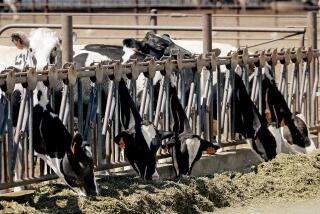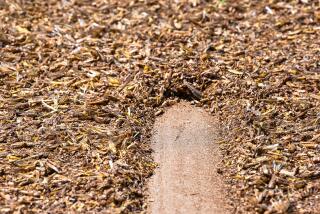Crop Stopper : Produce Supply Dwindles, Market Prices Soar as Whitefly Infestation Takes Toll
The effects of an infestation of poinsettia whiteflies are already beginning to show up in grocersâ produce bins. And consumers should brace themselves for a possible roller coaster ride of higher prices and shortages through the winter, warn growers, distributors and retailers.
Very few cantaloupes are available in grocery stores, and prices of leafy green vegetables are climbing as harvests in other parts of the country wind down and distributors anticipate shortages from the whitefly-infested areas.
âLettuce costs have more than doubled in one week,â said Jack H. Brown, chief executive of Stater Bros. stores. Brown said iceberg lettuce has gone to $18 a box from $8 last week, which is translating into prices of 90 to 99 cents per head.
The high cost of iceberg lettuce--and anticipation of shortages within a few weeks--has been driving up wholesale prices of other produce too. Grocers expect to pass along these price increases in the next few weeks.
At Jackâs Wholesale Produce Co. in Los Angeles, President Paul Krivitsky said Wednesday that prices on âall the greens are going up, jumping $2 to $3 a box a day. Yesterday, we paid $10 a box for romaine, today we paid $13. In good times, we might pay $5 a box--thatâs two dozen heads.â
Krivitsky, whose company supplies produce for grocers and restaurants, said âall the prices are expensive. . . . Merchandise is getting very short.â
The tiny whitefly is primarily damaging leafy vegetables, such as lettuce, broccoli and cabbage, as well as carrots. Farmers in the Imperial Valley, where the fly has hit the hardest, lost nearly 90% of their fall harvest of cantaloupes and worry that the spring crop of melons will be devastated as well unless the whitefly can be stopped.
Damage has already climbed to $84 million in such crops as cantaloupes and cotton, and could top $200 million by spring, according to the Imperial County Agriculture Commission.
Prices of leafy vegetables are likely to rise and fall in waves throughout the winter as shortages become known and goods become available from other areas, distributors and retailers say. And as consumers find shortages and make substitutions, price rises are likely in produce not directly affected by the whiteflies.
Compton-based Ralphs reports that it has no cantaloupes at any of its 157 stores in Southern California. Almost all of the fall harvest of the orange melon is from the Imperial Valley and other areas that also have been hit by the whitefly.
âToday, we are seeing shortages only in cantaloupes,â said Kerry Hodges, Ralphs vice president for produce. âBut next will come head lettuce, broccoli, cauliflower--and as the growers are telling us: Be prepared for shortages, lesser quality and higher prices.â
And yet Thanksgiving dinner tables can still be laden with winter vegetables, such as potatoes, yams and squash, that have not been attacked by the whiteflies. Even the delicate asparagus has so far escaped the âsuperbug,â as farmers are calling it.
Grocery store chains are busy checking with produce brokers in hopes of getting the vegetables from other parts of the winter growing area such as Arizona, Mexico and Texas that have not been as severely affected by the whitefly. âThere will be produce--at higher prices most likely, but there will be some,â said Hodges of Ralphs.
More to Read
Inside the business of entertainment
The Wide Shot brings you news, analysis and insights on everything from streaming wars to production â and what it all means for the future.
You may occasionally receive promotional content from the Los Angeles Times.










